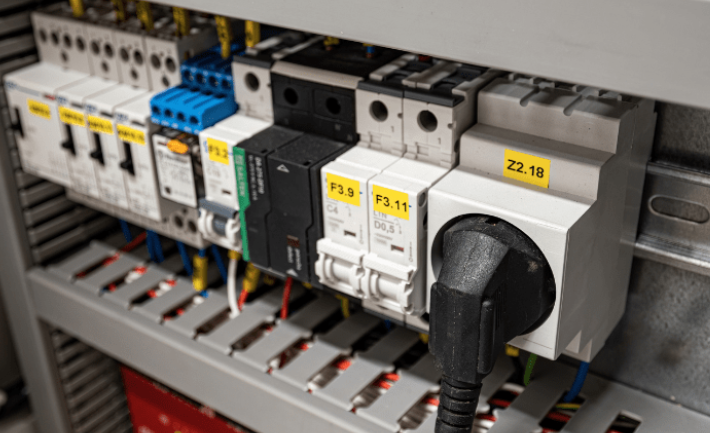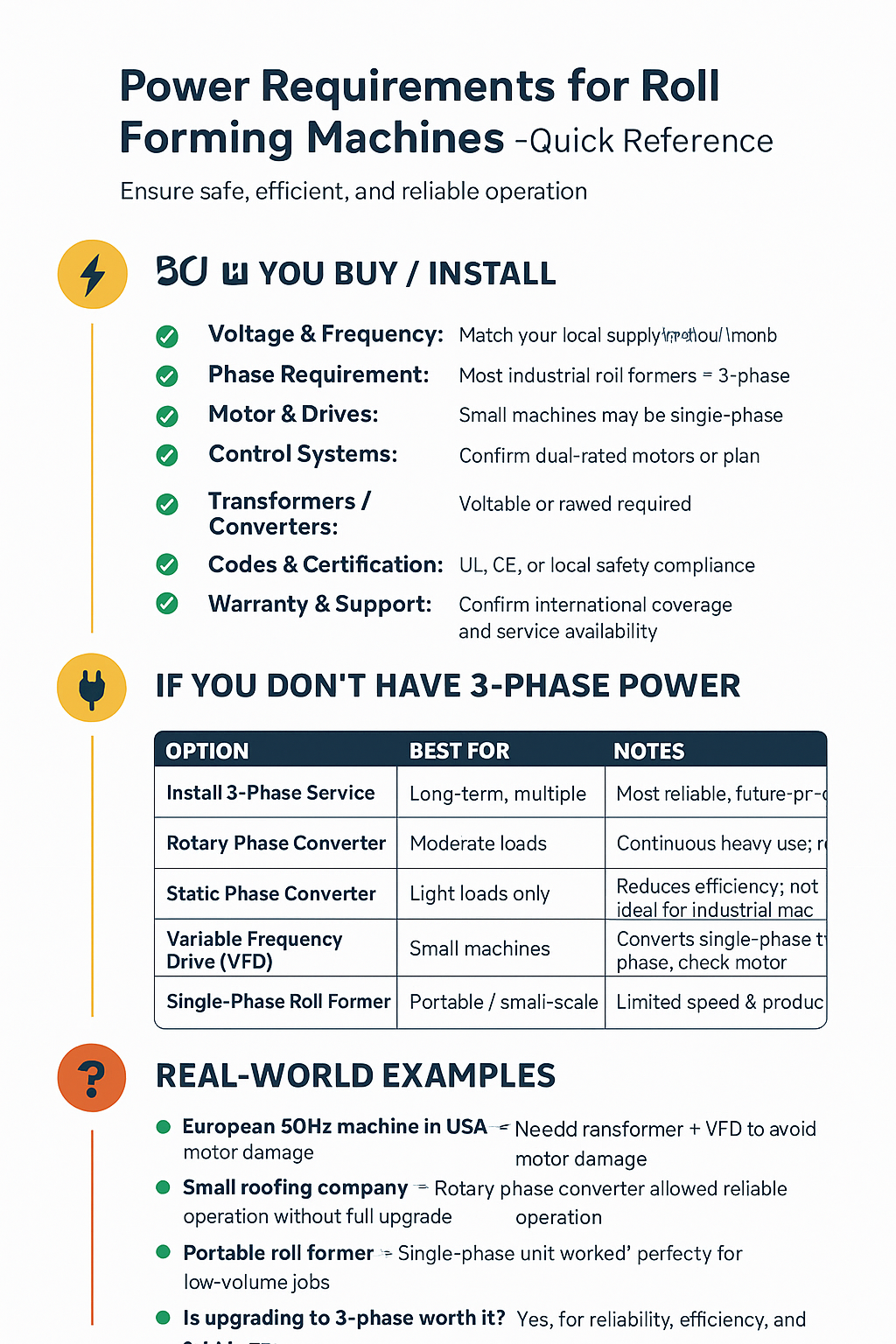
Posted on Tuesday, September 23, 2025
When investing in a new roll forming machine, one of the most overlooked but critical factors is power compatibility. Without the correct power supply, even the best machine won’t run safely, efficiently, or reliably. This guide explains why power requirements matter, why most roll formers use 3-phase power, what to check when buying internationally, what to do if you don’t have 3-phase available, and provides real-world examples of what can go wrong — or right.
Consistent operation – Roll formers need steady power to maintain speed and forming accuracy.
Precision forming – Voltage or frequency mismatches can lead to misformed profiles, uneven cuts, or material waste.
Throughput – Machines designed for high capacity will underperform if underpowered.
Motors and drives – Incorrect power can cause overheating, excessive wear, or permanent failure.
Hydraulics – Pumps require stable power to maintain pressure and cut cleanly.
Electronics – PLCs, sensors, and controls are sensitive to fluctuations.
Power mismatches can create electrical hazards, unexpected stoppages, and even fire risks.
Industrial roll formers are built to electrical codes in the country of manufacture. If the power setup doesn’t match your region, you may face failed inspections and delays.
Correct power ensures lower energy waste, fewer breakdowns, and extended equipment life.
Yes — the vast majority of roll forming machines run on 3-phase power.
It provides smooth torque, essential for precision forming.
It handles the heavy load of motors, hydraulic pumps, and shearing systems.
It’s standard in industrial facilities worldwide.
Exceptions:
Smaller, portable roofing roll formers may run on single-phase.
Some custom machines can be built for single-phase, but this limits speed and output.
Power standards vary worldwide, so checking compatibility before purchase is essential.
Voltage & Frequency
USA: 220/440V, 60Hz (3-phase)
Europe/Asia: 380/400/415V, 50Hz (3-phase)
Running a 50Hz machine on 60Hz (or vice versa) can damage motors and controls.
Phase Requirement
Confirm if the machine is single-phase or 3-phase.
A phase converter may be required if your facility setup is different.
Motor & Drive Compatibility
Some motors are dual-rated for 50/60Hz or multiple voltages.
Others may need rewiring or replacement.
Control Systems (PLCs, electronics)
Ensure they’re rated for your voltage/frequency.
Ask if they can be reprogrammed or adapted.
Transformers or Converters
Step-up or step-down transformers may be required.
Factor this cost into your purchase.
Electrical Codes & Certification
Machines must comply with your country’s safety standards (UL, CE, etc.).
Warranty & Support
Confirm whether the warranty is valid internationally.
Ask if remote or local support is available.
✅ Quick Checklist for International Buyers
Voltage, phase, and frequency match
Motor ratings are compatible
PLCs and controls are adaptable
Extra transformers/converters included if needed
Meets local safety codes
Warranty and service confirmed
Not every site has access to industrial power. Here are your main options:
Best long-term solution if you plan to run multiple machines.
Reliable and future-proof, but costly to set up depending on location.
Converts single-phase to 3-phase using a motor-generator system.
Reliable for continuous heavy loads.
Requires investment and some maintenance.
Low-cost option but reduces motor efficiency and risks overheating.
Not suitable for heavy-duty roll forming.
Some VFDs accept single-phase input and output 3-phase.
Ideal for smaller machines with moderate motors.
May not support larger multi-motor systems.
Available for smaller, portable, or roofing roll formers.
Limited in size, speed, and production capacity.
Example 1 – A European Machine in the U.S.
A U.S. company imported a roll former from Germany designed for 400V, 50Hz. Their factory ran 480V, 60Hz. Without adaptation, the motors overheated within weeks. The solution was installing a step-down transformer and VFDs, which cost thousands — nearly 20% of the machine price.
Lesson: Always check voltage and frequency before shipping.
Example 2 – Small Roofing Company Without 3-Phase
A roofing contractor in a rural area only had single-phase power. Instead of paying to upgrade the utility supply, they installed a rotary phase converter to run their new roll former. It worked reliably, allowing them to expand production without major electrical infrastructure changes.
Lesson: Converters can be a smart solution for smaller operations.
Example 3 – Choosing a Single-Phase Roll Former
A startup company needed a portable machine for on-site roofing jobs. They bought a single-phase roll former specifically designed for flexibility. It plugged directly into standard service and kept costs low, though it produced slower than larger 3-phase models.
Lesson: Single-phase roll formers can work well for niche, mobile, or small-scale applications.
Q1: Can I run a roll forming machine on single-phase power?
Yes, but only small or specially designed machines. Industrial roll formers almost always require 3-phase.
Q2: What happens if I connect a machine to the wrong voltage?
Motors can overheat or burn out, electronics can fail, and you may void the warranty. Always check compatibility first.
Q3: Can a VFD replace 3-phase power?
For small machines, yes. But for large roll formers with multiple motors, hydraulic systems, or high horsepower, a full 3-phase supply is recommended.
Q4: Do I need a transformer if I import a machine?
If your country’s voltage/frequency doesn’t match the machine’s design, yes. Transformers or converters may be necessary.
Q5: Is it worth upgrading my facility to 3-phase?
If you plan to run more than one industrial machine, absolutely. It’s the most stable, efficient, and future-proof solution.
Getting the power requirements right is not just a technical detail — it’s the foundation of a successful roll forming setup. Whether you’re installing a new machine locally or buying from overseas, take time to verify voltage, phase, and frequency compatibility.
If you don’t currently have 3-phase power, solutions exist — from converters and VFDs to installing full 3-phase service. The right choice depends on your machine size, production volume, and long-term growth plans.
Bottom line: A roll former is only as good as the power feeding it. Match your machine to the right electrical supply to protect your investment, ensure safety, and keep production running smoothly.
1. Check Voltage & Frequency
USA: 220/440V, 60Hz (3-phase)
Europe/Asia: 380/400/415V, 50Hz (3-phase)
Ensure the machine matches your local supply to avoid damage.
2. Confirm Phase Requirement
Most industrial roll formers = 3-phase.
Small or portable machines may be single-phase.
3. Motor & Drive Compatibility
Are motors dual-rated for your voltage/frequency?
Consider rewiring, replacement, or VFD if needed.
4. Control Systems (PLC/Electronics)
Check voltage/frequency rating.
Confirm PLCs can be reprogrammed or adapted.
5. Transformers / Converters
Step-up or step-down transformer may be needed.
VFDs can convert single-phase to 3-phase for smaller machines.
6. Local Codes & Certification
UL, CE, or local safety certification required.
7. Warranty & Support
Confirm international warranty coverage.
Check availability of remote or local technical support.
| Option | Best For | Notes |
|---|---|---|
| Install 3-Phase Service | Long-term, multiple machines | Most reliable, future-proof |
| Rotary Phase Converter | Moderate loads | Reliable for continuous heavy use |
| Static Phase Converter | Light loads only | Reduces efficiency; not ideal for industrial roll formers |
| Variable Frequency Drive (VFD) | Small machines | Converts single-phase to 3-phase; may not support large motors |
| Single-Phase Roll Former | Portable or small-scale | Limited speed & production |
European 50Hz machines in the USA need transformers/VFDs.
Small contractors can use a rotary phase converter to run 3-phase machines without full service upgrade.
Single-phase roll formers are ideal for portable or low-volume production.
Can I run a standard roll former on single-phase? Only small or specially designed machines.
What happens if voltage is wrong? Motors/electronics can fail; warranty may be voided.
Can a VFD replace 3-phase? For small machines yes; large industrial machines need proper 3-phase.
Is upgrading to 3-phase worth it? Yes, for reliability, future growth, and efficiency.


32/1000 Box Profile Roll Forming Machine – Complete Guide & Specifications
Posted on Sunday, November 16, 2025
High-performance 32/1000 box profile roll forming machine for roofing and cladding. Full specifications, profiles, applications, pricing

PBR / R-Panel Roll Forming Machine – Complete Guide & Specifications
Posted on Sunday, November 16, 2025
PBR / R-Panel roll forming machine for roofing and wall cladding. Full specs, profiles, applications, pricing, and global buying guide. Built to order.

Posted on Sunday, November 16, 2025
How to Diagnose and Fix the Hidden Electrical Problems That Cause Downtime
Copyright 2025 © Machine Matcher.